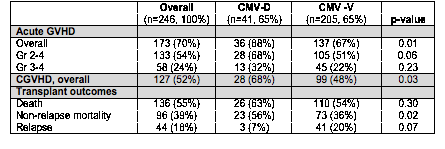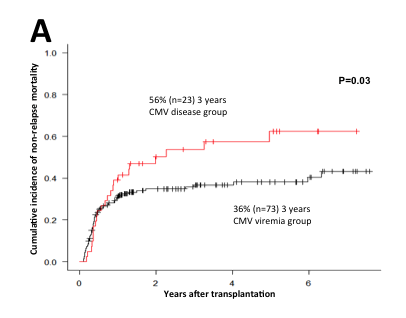Abstract

Introduction:
Cytomegalovirus disease (CMV-D) is a major complication following allogeneic hematopoietic stem cell transplant (HSCT). CMV monitoring and preemptive therapy has been effective in decreasing CMV disease rates but this disease remains a challenge for many patients, especially with the increasing trend of using alternative donors, T-cell depletion (TCD) and more immunosuppressive regimen. In this study, we attempted to evaluate clinical characteristics; risk factors for progression from CMV viremia (CMV-V) to disease and the impact on transplant outcomes.
Methods:
A total of 548 patients were evaluated after receiving HSCT between 2005 and 2012 at Princess Margaret Cancer Centre for occurrence of CMV infection (viremia or disease). CMV-V was diagnosed in peripheral blood samples obtained on two occasions either by PCR (³ 200 IU/ml) or antigenemia testing (³2 positive cells/100000). CMV disease (CMV-D) was defined by pathological evidence of virus in the involved organ. A total of 246 were included in the analysis. Patients were stratified into two groups, CMV-V only group versus CMV-D with or without preceding viremia.
The CMV-D group median age was 50 years (range 17-71) and 17 (34%) were female. Matched related donors were used for twenty-two patients (54%). Twenty-four patients (59%) were transplanted for a myeloid and 15 (37%) for a lymphoid malignancy. Twenty patients (49%) were CMV sero-positive recipient and negative donor (R+D-) while 20 (49%) were recipient and donor CMV sero-positive (R+D+) and 1 (2%) was CMV sero-negative recipient and sero-positive donor (R-D+). Graft versus host disease (GVHD) prophylaxis included CSA/MMF (n=19, 46%) and CSA/MTX (n=22, 54%). Conditioning regimen with myeloablative preparative regimens were administered to 29 patients (71%), 12 patients (29%) were treated with reduced intensity regimen (RIC). Thirty-seven patients (90%) received peripheral blood stem cells as a stem cell source. In vivo TCD with alemtuzumab was used in 15 (37%).
Results: With a median follow-up of 40 months among survivors (range 12-88), CMV-D occurred in 17% (n=41). The median time of onset of CMV-D was 11 months (range 1-88). CMV-D was preceded by viremia in 89% (n=36) versus 11% (n=5) without previous viremia. >3 CMV-V events occurred prior to disease in 39% (n=14) versus 1-2 events in 61%(n=22) of patients. CMV-D affected the lung in 76% (n=31), colon in 15% (n=6), retina in 2% (n=1), liver in 2% (n=1) and 5% of the patients had multi-organ involvements (n=2). Multiple CMV-D (> 2) occurred in 17% (n=7) of the patients. The involved organs differ only in 25% (n=2) of the patients.
The transplant outcomes showed higher incidence of acute and chronic GVHD in CMV-D group (Table 1) and NRM (p=0.03; Fig 1B) in CMV-D group but no confirmed differences in OS or relapse.
Transplant outcomes according to the occurrence of CMV infection following allogeneic HSCT
Transplant outcomes according to the occurrence of CMV infection following allogeneic HSCT
A multivariate analysis for the risk of progression from viremia to disease demonstrated chronic GVHD (p< 0.03, HR 2.09) together with the use of total body irradiation (TBI) of 1200 cGY (P=0.01, HR 2.77) as an independent risk factors. Neither CMV sero-status nor the numbers of previous CMV-V events were confirmed as independent factors. For survival analyses, CMV-D was not confirmed as independent risk factor for NRM, OS or relapse.
A correlation between the time of diagnosis with CMV-D and NRM using the ROC analysis showed day 120 as significant cutoff with AUC=0.722 (sensitivity=0.522, specificity=0.800). The NRM & OS in early CMV-D (i.e. within 120 days from HSCT) was 80% and 7% versus 42% (P=0.004) and 54% (P=0,003) in late CMV-D group (>120 days; Fig 1A), respectively. There were no differences in relapse rate between both groups.
The cumulative incidence of grades 1-4 acute GVHD, grades 2-4, grades 3-4 at day 120 and overall chronic GVHD at 2 years in early CMV-D was 93%, 87%, 73% and 27% versus 85%, 58%, 7% and 92% in late CMV-D group, suggesting very higher incidence of severe acute GVHD in early CMV-D versus higher incidence of chronic GVHD in late CMV-D.
Conclusion:
1) Chronic GVHD and TBI 1200cGY are independent risk factors for progression from CMV-V to disease. 2) CMV-D may occur without proceeding viremia 3) Early CMV-D within the first 120 days from allogeneic HSCT is associated with very higher mortality rate which probably affected in part by the occurrence of severe acute GVHD.
No relevant conflicts of interest to declare.
Author notes
Asterisk with author names denotes non-ASH members.

This icon denotes a clinically relevant abstract




This feature is available to Subscribers Only
Sign In or Create an Account Close Modal